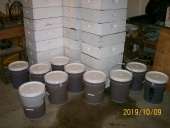



elle sagenev wrote:Peoples, that took FOREVER and the pay off, I don't know. We probably have 1-2 gallons of honey from what is going on 3 days of work now. Of course, it's not 3 days of constant work it's a lot of waiting for things to filter and drip down.
I borrowed a 2 frame honey spinner. I think I had 10 frames that were spinnable. I had some frames that I didn't use plastic foundation with and the bees didn't go straight down and I couldn't spin the honey from them. So, I removed the comb from them, put them in cheesecloth and squished them up so the honey would drip down into a bucket.
Anyway, just took a lot of time and effort and I'm not sure it was worth it.
So I must be doing it wrong or something stupid because it just was terrible!

Nick Turner wrote:.... he is a little too technical for my taste....

Dell Knapp wrote: I am still a baker for the market in Madison, Wi & wanted to share this, hoping it gives you more tasty options !


Gabriel Lavinsky wrote:Considering all this info, i would really like to understand if some uses of reused tire are really interesting, such as using it for leveling the ground, burying it for ecological sanitary uses or for building house walls with it.